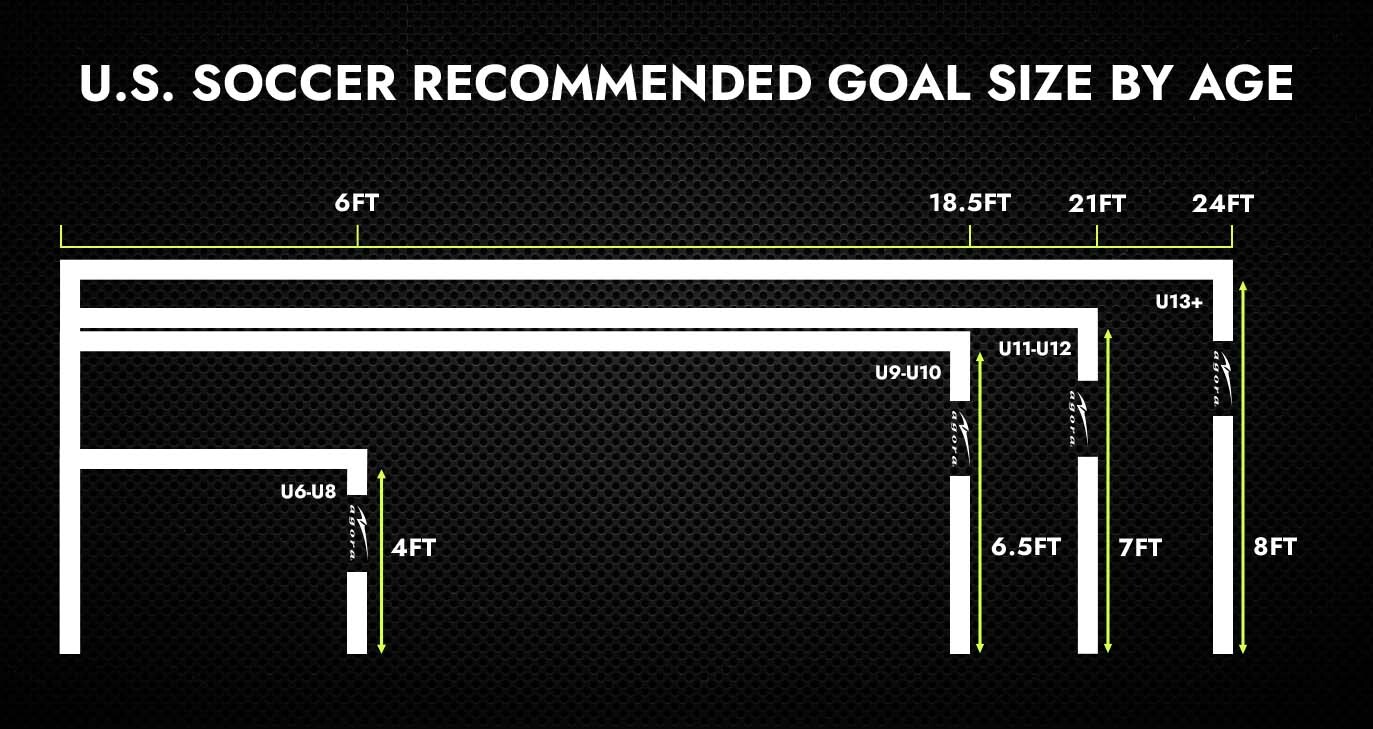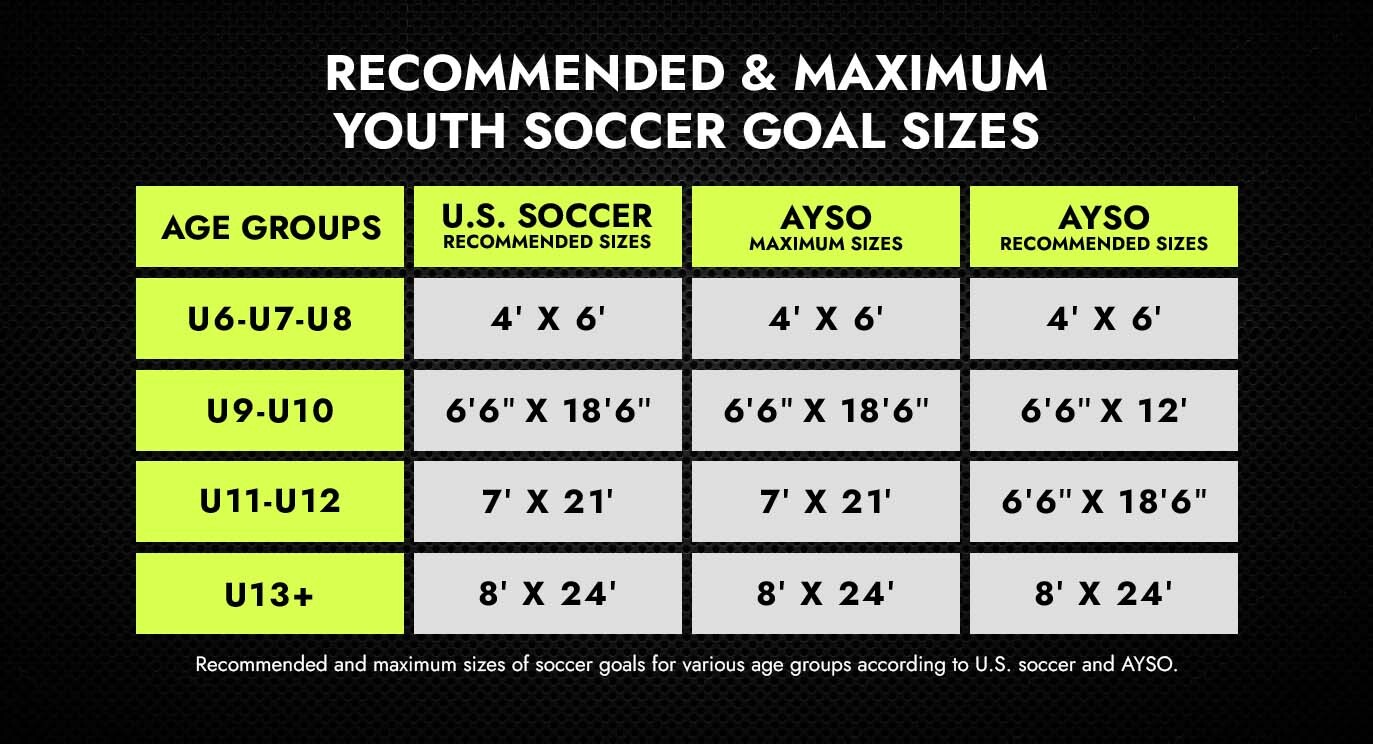There are no products listed under this category.
Goal Guide
Ultimate Soccer Goal Guide: U.S. Soccer Requirements, Buying Tips & More
If you're new to the soccer world, you’ve probably realized one thing quickly—soccer goals aren’t one-size-fits-all. From backyard setups to official league play, and from kids to teens, the goal dimensions vary widely depending on age and purpose (practice vs. competition), and even the organization involved. Different soccer organizations across the U.S. have their own rules and recommendations when it comes to soccer goal sizes, especially at the youth level. It’s enough to make your head spin. If you want to understand the different standards for each of the top organizations as quickly as possible, then this is the guide for you.
Important: Always check and confirm with your league before making a purchase to ensure you’re meeting their exact specifications.
| Organization | Goal Size (HxW) | Crossbar/ Post Diameter | Goal Color |
| FIFA (International Federation of Association Football) | 8' x 24' | 4" - 5" | Goal must be white |
| FIFA Futsal | 2M x 3M (6'7" x 9'10") | 8cm (3") | Goal must be a different color than the pitch |
| NCAA (National Collegiate Athletic Association) | 8' x 24' | 4" - 5" | Goal must be white |
| NFHS (National Federation of State High School Associations) | 8' x 24' | 3" - 5" | Goal must be white |
| U.S. Youth Soccer | See chart below | -- | -- |
| AYSO (American Youth Soccer Organization) | See chart below | -- | -- |
| MASL (Major Arena Soccer League) | 8' x 14' | 4" - 5" | Goal must be red |

Youth Soccer Goal Requirements
If you’ve ever wondered why the goals at your 6-year-old’s soccer game look more like hockey nets and the ones at your teen’s game look like something out of a professional tournament, you’re not imagining things. Youth soccer uses different goal sizes by age for one very good reason: development. Here’s why it matters:
1) Safety: Younger players aren’t physically equipped to defend or shoot on full-size goals — it's simply not safe or fair.
2) Skill Building: Smaller goals help young players focus on technique, ball control, and accuracy, not just blasting the ball.
3) Age-Appropriate Play: Right-sized goals ensure games stay competitive and fun, without overwhelming young players or goalkeepers.
Think of it like using a smaller basketball hoop for kids — it's all about setting them up for success as they grow. And with the reasons why goal sizes vary out of the way, here are the recommended and maximum goal sizes for U.S. Youth Soccer (download guide) and AYSO.
U.S. Youth Soccer
U.S. Youth Soccer is part of U.S. Soccer, which has been a proud member of FIFA—the international governing body of soccer—since 1913. When it comes to goal sizes for youth games, U.S. Youth Soccer follows the recommendations laid out by U.S. Soccer’s Small-Sided Games Standards, which specify the maximum allowable goal dimensions for age groups U6 through U12. These guidelines are designed to ensure games remain developmentally appropriate, safe, and fun. It’s important that teams and clubs do not exceed these maximum goal sizes, especially for younger age groups. U.S. Youth Soccer does allow for slight adjustments to these goal sizes if needed to better suit your field setup — as long as those changes don’t negatively impact the quality of play. This flexibility helps clubs work with the space and equipment they have, without compromising the player experience. Here are the recommended maximum goal sizes for U.S. Youth Soccer:
U6, U7, U8 Max recommended goal size: 4'x6′
U9, U10 Max recommended goal size: 6.5’x18.5’
U11, U12 Max recommended goal size: 7′x21′
U13+ Max recommended goal size: 8′x24′
AYSO (American Youth Soccer Organization)
AYSO isn’t just one of the biggest names in youth soccer — it’s also the oldest national youth soccer program in the United States. Founded as a non-profit, AYSO has been shaping young players for generations with a focus on fun, fairness, and skill development. AYSO is organized into Regions, Areas, and Sections, all powered by dedicated volunteers who help run local programs across the country. AYSO follows the IFAB Laws of the Game as its official rulebook, with age-specific adaptations to support player development. AYSO’s Small-Sided Games format emphasizes age-appropriate field sizes, team sizes, and goal sizes. Below are the maximum and recommended goal dimensions by age group, according to their national guidelines:
U6, U7, U8 Max recommended goal size: 4′x6′
U9, U10 Max goal size: 6.5’x18.5’ | Recommended: 6.5’x12′
U11, U12 Max goal size: 7′x21′ | Recommended: 6.5’x18.5’
U13+ Max recommended goal size: 8′x24′

Buyer's Guide: Tips Before Your Purchase
Purpose: When it comes to buying a soccer goal, one of the most important factors to consider is its purpose. Are you buying it for casual practice, or for competitive match play? Understanding how and where the goal will be used will help you make a smarter purchase and avoid unnecessary frustration down the line. Practice goals are ideal for training sessions, individual drills, and recreational play. These goals are typically designed to be lightweight, portable, and easy to set up or take down. Many practice goals are made from materials like aluminum or PVC, and some even feature pop-up or foldable designs that make them perfect for backyards, parks, or temporary training fields. They’re often smaller in size to support specific training drills, and they offer the flexibility to be used just about anywhere. On the other hand, competition goals are built for official games and serious team play. These goals are made from heavy-duty materials and are designed to withstand the rigors of repeated, high-impact use. They often meet the size and safety standards set by governing bodies like FIFA or local leagues, and are usually intended to remain in place on dedicated soccer fields. Because of their sturdier construction, they are less portable but far more durable, making them a better fit for schools, clubs, and professional facilities.
Quality and Durability: Investing in a high-quality, durable goal is crucial. Look for goals made from sturdy materials such as heavy-duty aluminum, which offer durability and resistance to wear and tear. Relatively lightweight without having to sacrifice strength or rigidity, aluminum goals are rust-proof and generally outlast the life of steel or PVC plastic goals, and can withstand rugged daily use. Steel goals, an alloy of iron and carbon, are usually less expensive and heavier than aluminum goals, yet more susceptible to rust and deterioration. Fiberglass goals, lightweight yet sturdy, are associated more commonly with pop-up goals, and can endure light to moderate play. Plastic goals offer the least amount of long-term lifespan as they are vulnerable to breaks and sun-based warping. Semi-permanent goals, which can be made permanent with the proper ground anchors, are recommended for those with dedicated soccer fields or require a heavy-duty goal for rugged use. Semi-permanent goals typically require two or more people for assembly, along with tools and hardware.
Safety and Stability: Ensuring the safety of players and spectators should be a top priority. Goals should be stable and secure, minimizing the risk of tipping or collapsing during intense gameplay. The Consumer Product Safety Commission (CPSC) released guidelines for goal safety to prevent accidents and injuries. Choose goals with secure anchoring systems and ground stakes to provide stability to prevent goal tip-over. Goals with a back-bottom bar adds more weight to the back of the goal further reducing the risk of tip-over. Also, goals with round bars offers greater safety compared to sharp, square-shaped goals.
Portability and Storage: For those who require a portable setup or have limited storage space, the portability factor becomes crucial. Pop-up goals with foldable/collapsible frames offer convenient portability while maintaining durability. Some options even come with storage bags for easy transportation. Additionally, consider goals that are easy to assemble and disassemble, with little to no tools required, as this can save valuable time during training sessions or matches.
Field Type: Determine whether your goal will be used on grass or other field types, such as type, hardwood, as well as indoor or outdoor play, or possibly even both. Most outdoor goals are manufactured to withstand harsh ambient elements, including wind, rain, heat, and UV degradation. Indoor goals are designed to accommodate more delicate surfaces, including turf or hardwood.
Net Attachment: Selecting the proper goal net attachment system can save you time and money down the road. Clip-Less Net Systems easily allows a net to latch onto an inline set of hook-shaped grooves built into the goal's frame, avoiding the need for net clips or ties. For speed and long-term savings, this is the way to go. Net-Clip Systems pin down the net into the goal's channel system using net clips. Net ties and net straps typically require more time than the options above. This system is more prevalent in portable goals.
Choosing a goal is a significant decision that can impact your game and overall experience. By understanding your needs, considering factors such as quality, safety, portability, and environment, you can make an informed decision that aligns with your goals as a player or team. Remember to prioritize safety and invest in a goal that will withstand the rigors of the game. At Sator Soccer, we pride ourselves in offering high-quality, competitively priced goals in variety of styles for all ages and levels of play. For additional support on inquires, contact us.
